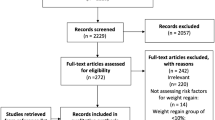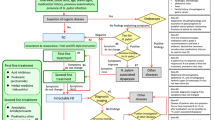Abstract
Sliding hiatal hernia is a common endoscopic finding with a prevalence that increases with the age of patients. Although nearly all patients with GERD have HH, only a minority of patients with hernia reports reflux symptoms. Our hypothesis is that H. pylori infection may be responsible for the high number of asymptomatic hernias. After exclusion of patients with peptic ulcer, 507 patients with an endoscopic diagnosis of hernia were considered. Patients were divided into three groups: A, ≤45 years, 141 patients; B, 46–60 years, 144 patients; and C, ≥61 years, 222 patients. Presence of reflux symptoms (questionnaire) and esophagitis, H. pylori status, and gastric histology were recorded. The prevalence of hernia in the total series was 11% in group A, 23% in B, and 38% in C. Aging was associated with a significant increase in H. pylori prevalence and corpus gastritis scores, and a parallel decrease of GERD symptom prevalence, which was 66.6% in group A, 52.1% in B, and 46.8% in C (P < 0.01). Taking the three groups together, prevalence of H. pylori infection was higher in patients without GERD than with GERD (66.4 vs 57.3%, P < 0.05), and higher in patients with nonerosive GERD than erosive GERD (62.8 vs 48.6%, P = 0.02); corpus gastritis scores were significantly higher in patients without GERD than those with GERD and in those with nonerosive than erosive GERD. In conclusion, H. pylori infection protects against development of GERD in subjects with hiatus hernia. This effect is significantly more evident in the elderly where, in spite of the high prevalence of hernia, only a small number of individuals develop GERD. The development of a corpus-predominant gastritis is probably responsible for this effect.
Similar content being viewed by others
References
Postlethwait RW: Hiatal hernia and gastroesophageal reflux. In RW Postlethwait (ed.). Surgery of the Esophagus, 2nd ed. Norwalk, Appleton-Century-Crofts, 1986
Sloan S, Rademaker AW, Kahrilas PJ: Determinants of gastroesophageal junction incompetence: hiatus hernia, lower esophageal sphincter, or both? Ann Intern Med 117:977-982, 1992
Michelson E, Siegel CI: The role of the phrenico-esophageal ligament in the lower esophageal sphincter. Surg Gynecol Obstet 118:1291-1294, 1964
Sloan S, Kahrilas PJ: Impairment of esophageal emptying with hiatus hernia. Gastroenterology 100:596-605, 1991
Berstad A, Weberg R, Froyshov Larsen I, et al: Relationship of hiatus hernia to reflux oesophagitis. Scand J gastroenterol 21:55-58, 1986
Petersen H, Johannessen T, Sandvik AK, et al: Relationship between endoscopic hiatus hernia and gastroesophageal reflux symptoms. Scand J Gastroenterol 26:921-926, 1991
Sontag SJ: Rolling review: gastroesophageal reflux disease. Aliment Pharmacol Ther 7:293-312, 1993
Labenz J, Blum AL, Bayerdoerffer E, et al: Curing Helicobacter pylori infection in patients wit duodenal ulcer may provoke reflux esophagitis. Gastroenterology 112:1442-1447, 1997
El-Omar EM, Oien K, El-Nujumi A, et al: Helicobacter pylori infection and chronic gastric acid hyposecretion. Gastroenterology 113:15-24, 1997
Goggin PM, Marrero JM, Ahmed H, et al: Urea hydrolysis in Helicobacter pylori infection. Eur J Gastroenterol Hepatol 93:927-933, 1991
Graham DY, Malaty HM, Evans DG, et al: Epidemiology of Helicobacter pylori in asymptomatic population in the United States. Effect of age, race, and socioeconomic status. Gastroenterology 100:1495-1501, 1991
Hackelsberger A, Guenther T, Schultze V, et al: Role of aging in the expression of Helicobacter pylori gastritis in the antrum, corpus and cardia. Scand J Gastroenterol 34:138-143, 1999
Boyce HW: Hiatal hernia and peptic disease of the esophagus. In MV Sivak (ed.). Gastroenterologic Endoscopy. Philadelphia, Saunders, 1987
Johnson NJ, Boyd EJ, Mills JG, et al. Acute treatment of reflux esophagitis: A multicentre trial to compare 150 mg ranitidine b.i.d. with 300 mg ranitidine q.d.s. Aliment Pharmacol Ther 1989; 3:259-266
Dixon MF, Sobala GM: Gastritis and duodenitis: the histopathological spectrum. Eur J Gastroenterol Hepatol 4(suppl 2):17-23, 1992
Stolte M, Stadelmann O, Bethke B, et al: Relationships between the degree of Helicobacter pylori colonization and the degree of activity of gastritis, surface epithelial degeneration and mucus secretion. Z Gastroenterol 33:89-93, 1995
Manes G, Lioniello M, de Nucci C, et al: Reflux symptoms preexist and do not appear after curing H. pylori infection in duodenal ulcer patients. Scand J Gastroenterol (in press)
Beil W, Birkholz C, Wagner S, Sewing K-F: Interaction of Helicobacter pylori and its fatty acids with parietal cells and gastric H+/K+-ATPase. Gut 25:1176-1180, 1994
Raiha I, Impivaara O, Seppala M, et al: Prevalence and characteristics of symptomatic gastroesophageal reflux disease in the elderly. J Am Geriatr Soc 40:1209-1211, 1992
Zhu H, Pace F, Sangaletti O, et al: Features of symptomatic gastroesophageal reflux in elderly patients. Scand J Gastroenterol 28:235-238, 1993
Raiha I, Hietanen E, Sourander LB: Symptoms of gastro-oesophageal reflux disease in elderly people. Age Ageing 20:365-370, 1991
Lash H, Castell D: Evidence for diminished visceral pain. Gastroenterology 106:A1035, 1994
Kekki M, Samloff IM, Ihamaki T, et al: Age and sex-related behaviour of gastric acid secretion at the population level. Scand J Gastroenterol 17:737-743, 1982
DeKoster E, Ferhat M, Deprez C, et al: H. pylori, gastric histology and gastro-oesophageal reflux disease. Gut 37(suppl 1):A36, 1995
Manes G, Mosca S, Laccetti M, et al: Helicobacter pylori infection, pattern of gastritis and symptoms in erosive and non-erosive gastroesophageal reflux disease. Scand J Gastrenterol 34:658-662, 1999
Author information
Authors and Affiliations
Rights and permissions
About this article
Cite this article
Manes, G., Pieramico, O., Uomo, G. et al. Relationship of Sliding Hiatus Hernia to Gastroesophageal Reflux Disease: A Possible Role for Helicobacter pylori Infection?. Dig Dis Sci 48, 303–307 (2003). https://doi.org/10.1023/A:1021927526790
Issue Date:
DOI: https://doi.org/10.1023/A:1021927526790




